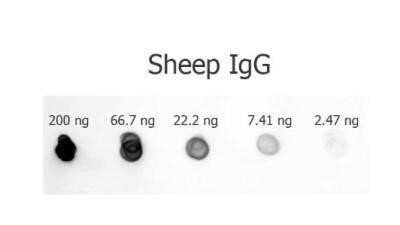Rabbit anti-Sheep IgG (H+L) Secondary Antibody
Novus Biologicals, part of Bio-Techne | Catalog # NBP1-72704

![Immunocytochemistry/ Immunofluorescence: Rabbit anti-Sheep IgG (H+L) Secondary Antibody [NBP1-72704] Immunocytochemistry/ Immunofluorescence: Rabbit anti-Sheep IgG (H+L) Secondary Antibody [NBP1-72704]](https://resources.bio-techne.com/images/products/Rabbit-anti-Sheep-IgG-H+L-Secondary-Antibody-Immunocytochemistry-Immunofluorescence-NBP1-72704-img0004.jpg)
Conjugate
Catalog #
Forumulation
Catalog #
Key Product Details
Species Reactivity
Sheep
Applications
Dot Blot, ELISA, Fluorophore-linked immunosorbent assay, Immunocytochemistry/ Immunofluorescence, Immunohistochemistry, Immunohistochemistry-Paraffin, Western Blot
Label
Unconjugated
Antibody Source
Polyclonal Rabbit IgG
Concentration
Please see the vial label for concentration. If unlisted please contact technical services.
Product Specifications
Immunogen
Sheep IgG whole molecule
Clonality
Polyclonal
Host
Rabbit
Isotype
IgG
Description
This product was prepared from monospecific antiserum by immunoaffinity chromatography using Sheep IgG coupled to agarose. Assay by immunoelectrophoresis resulted in a single precipitin arc against anti-Rabbit Serum, Sheep IgG and Sheep Serum.
Store vial at 4C prior to opening. This product is stable for several weeks at 4C as an undiluted liquid. Dilute only prior to immediate use. For extended storage aliquot contents and freeze at -20C or below. Avoid cycles of freezing and thawing.
Store vial at 4C prior to opening. This product is stable for several weeks at 4C as an undiluted liquid. Dilute only prior to immediate use. For extended storage aliquot contents and freeze at -20C or below. Avoid cycles of freezing and thawing.
Scientific Data Images for Rabbit anti-Sheep IgG (H+L) Secondary Antibody
Immunocytochemistry/ Immunofluorescence: Rabbit anti-Sheep IgG (H+L) Secondary Antibody [NBP1-72704]
Immunocytochemistry/Immunofluorescence: Rabbit anti-Sheep IgG (H+L) Secondary Antibody [NBP1-72704] - Immunocytochemistry/Immunofluorescence: Rabbit anti-Sheep IgG (H+L) Secondary Antibody [DyLight 488] [NBP1-72996] Image from the DyLight 488 version of this antibody.
Dot Blot: Rabbit anti-Sheep IgG (H+L) Secondary Antibody [NBP1-72704] - Sheep IgG. Load: 200 ug, 66.7 ug, 22.2 ug, 7.41 ug or 2.47 ug as indicated. Primary antibody: N/A. Secondary antibody: Alkaline Phosphatase Conjugated Rabbit anti-Sheep IgG Antibody. Block: Blocking Buffer for Fluorescent Western Blotting at RT for 1 hour.
Fluorophore-linked immunosorbent assay: Rabbit anti-Sheep IgG (H+L) Secondary Antibody [NBP1-72704]
Fluorophore-linked immunosorbent assay: Rabbit anti-Sheep IgG (H+L) Secondary Antibody [NBP1-72704] - Using the DyLight 405 format of this antibody.Applications for Rabbit anti-Sheep IgG (H+L) Secondary Antibody
Application
Recommended Usage
ELISA
1:50000 - 1:200000
Immunohistochemistry
1:1000 - 1:5000
Immunohistochemistry-Paraffin
1:200-1:500
Western Blot
1:2000 - 1:10000
Application Notes
This product has been tested by ELISA and is suitable for use in ELISA, immunohistochemistry, and western blot. Specific conditions for reactivity should be optimized by the end user.
Formulation, Preparation, and Storage
Purification
Immunogen affinity purified
Formulation
0.02 M Potassium Phosphate, 0.15 M Sodium Chloride, pH 7.2
Preservative
0.01% Sodium Azide
Concentration
Please see the vial label for concentration. If unlisted please contact technical services.
Shipping
The product is shipped with polar packs. Upon receipt, store it immediately at the temperature recommended below.
Stability & Storage
Store at 4C short term. Aliquot and store at -20C long term. Avoid freeze-thaw cycles.
Background: IgG (H+L)
The 4 IgG subclasses, sharing 95% amino acid identity, include IgG1, IgG2, IgG3, and IgG4 for humans and IgG1, IgG2a, IgG2b, and IgG3 for mice. The relative abundance of each human subclass is 60% for IgG1, 32% for IgG2, 4% for IgG3, and 4% for IgG4. In an IgG deficiency, there may be a shortage of one or more subclasses (4).
References
1. Painter RH. (1998) Encyclopedia of Immunology (Second Edition). Elsevier. 1208-1211
2. Chapter 9 - Antibodies. (2012) Immunology for Pharmacy. Mosby 70-78
3. Schroeder H, Cavacini, L. (2010) Structure and Function of Immunoglobulins. J Allergy Clin Immunol. 125(2 0 2): S41-S52. PMID: 20176268
4. Vidarsson G, Dekkers G, Rispens T. (2014) IgG subclasses and allotypes: from structure to effector functions. Front Immunol. 5:520. PMID: 25368619
Additional IgG (H+L) Products
Product Documents for Rabbit anti-Sheep IgG (H+L) Secondary Antibody
Product Specific Notices for Rabbit anti-Sheep IgG (H+L) Secondary Antibody
This product is for research use only and is not approved for use in humans or in clinical diagnosis. Secondary Antibodies are guaranteed for 1 year from date of receipt.
Loading...
Loading...
Loading...
Loading...

![Fluorophore-linked immunosorbent assay: Rabbit anti-Sheep IgG (H+L) Secondary Antibody [NBP1-72704] Fluorophore-linked immunosorbent assay: Rabbit anti-Sheep IgG (H+L) Secondary Antibody [NBP1-72704]](https://resources.bio-techne.com/images/products/Rabbit-anti-Sheep-IgG-H+L-Secondary-Antibody-Fluorophore-linked-immunosorbent-assay-NBP1-72704-img0007.jpg)
![ELISA: Rabbit anti-Sheep IgG (H+L) Secondary Antibody [NBP1-72704] ELISA: Rabbit anti-Sheep IgG (H+L) Secondary Antibody [NBP1-72704]](https://resources.bio-techne.com/images/products/Rabbit-anti-Sheep-IgG-H+L-Secondary-Antibody-ELISA-NBP1-72704-img0008.jpg)